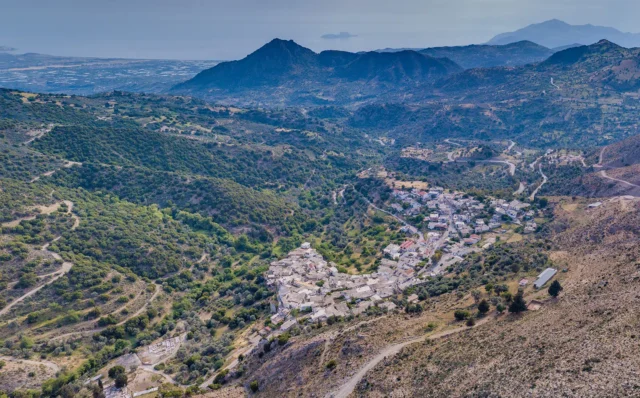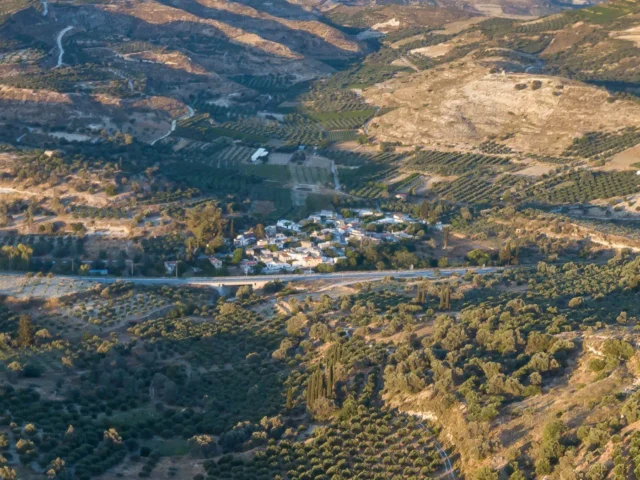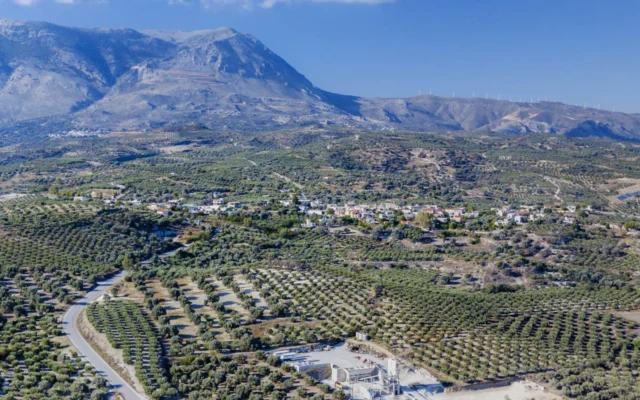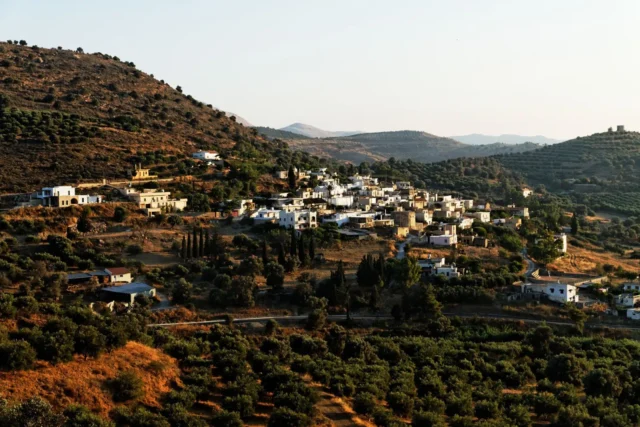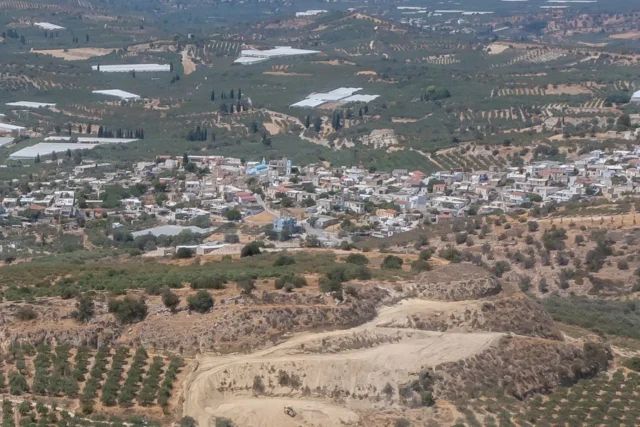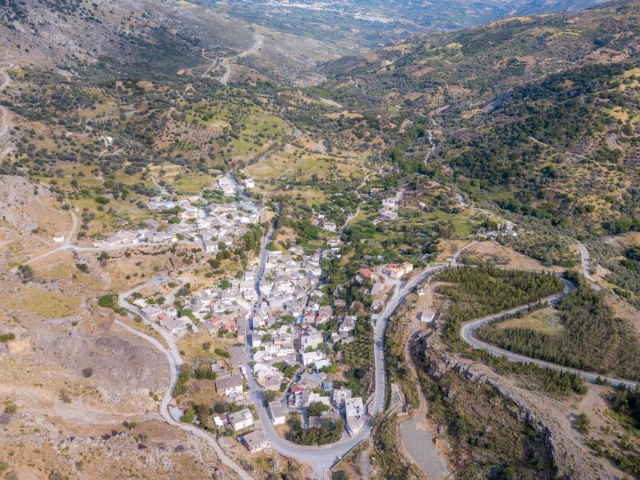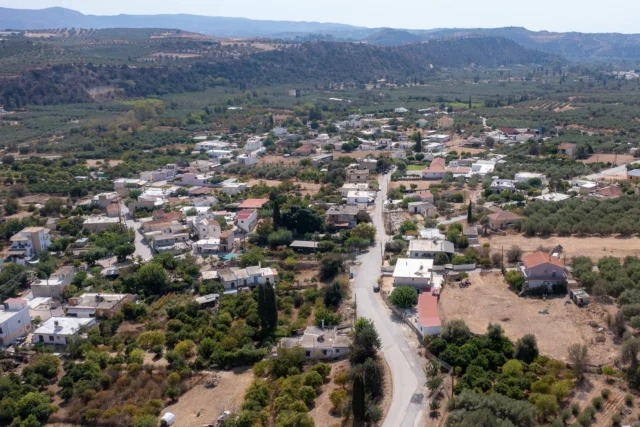86
listings found
Categories
Active filters:
Sivas, Phaistos
Sivas is a settlement located in the Heraklion regional unit on the island of Crete, Greece. It belongs to the Municipality of Phaistos
Kamares, Phaistos
Kamares, a village nestled in the foothills of Mount Ida, Crete, is historically significant due to its proximity to the Kamares Cave. This cave was a vital Minoan religious center, renowned for the discovery of Kamares Ware pottery, dating back to 2000 BC. The village, at an elevation of 600 meters, offers scenic views and a rich history, attracting tourists interested in Minoan civilization and the nearby Ideon Antro Cave. Its population, around 331 in 2011, engages in agriculture, livestock farming and tourism-related activities. Kamares blends its historical past with modern life, offering visitors a glimpse into Cretan heritage.
Matala, Phaistos
Located 68 km from Heraklion on Crete's southern coast, this village is famed for its beach and cliffs with carved caves. Historically, it served as the Minoan port for Phaistos and the Roman port for Gortyn. The caves, used as tombs in the Roman and Christian eras, feature rooms and stairs, suggesting they were also dwellings. In the 1960s and 70s, they became a sanctuary for hippies, including Joni Mitchell and Bob Dylan, an era that ended with the Greek military junta.
Plouti, Phaistos
Plouti is a settlement located in the Heraklion regional unit on the island of Crete, Greece. It belongs to the Municipality of Phaistos
Moroni, Phaistos
Moroni is a settlement located in the Heraklion regional unit on the island of Crete, Greece. It belongs to the Municipality of Phaistos
Kouses, Phaistos
Kouses, located in the Heraklion regional unit on the island of Crete, Greece, is a village with a rich history. The village sits on the northern foothills of Mount Pyrgos, offering a panoramic view of the Kato Messara plain. Kouses is located about 61 kilometers from Heraklion and is close to Phaistos. The village was once a fiefdom of the Kourmoulis family during the Ottoman occupation. The Kourmoulis family were Crypto-Christians who secretly practiced Christianity. According to local tradition, a clandestine school operated in Kouses. Two towers belonging to the Kourmoulis family still stand in Kouses. Within one of these towers lies the church of Agia Pelagia, where Crypto-Christians would gather in secret to worship. Other churches in the village include those dedicated to Agios Antonios, Agioi Pantes, and Agios Georgios. Additionally, there is the church of the Dormition of Agia Anna.
Petrokefali, Phaistos
Petrokefali, a village in the Municipality of Phaistos, Crete, has a long history, dating back to Venetian censuses where it was recorded as Petrochieffali. The village is located at the 59.3rd kilometer of the road to Matala. In 2021, its population was 813. The inhabitants are mainly engaged in agriculture, particularly olive growing and the cultivation of citrus fruits and early vegetables. Historically, the area was also known for rice cultivation. Petrokefali has a Cultural Association of Ladies, an Adult Education Center, a kindergarten, and a primary school. The village is also known for its connection to the Cretan Revolution against the Ottomans, particularly through figures like Michael Kourmoulis and Xopateras. The abandoned village of Flambanochori, located south of Petrokefali, is believed to have been deserted due to the devastating plague of 1592.
Listaros, Phaistos
Listaros, a small village nestled in the Asterousia Mountains of southern Crete, boasts a rich history dating back to the 16th century. First mentioned in historical records from 1577, the village was designated as "Vakoufiko" during the Ottoman period, with its income supporting religious institutions and charitable works. Archaeological surveys in the 1980s revealed the village's strategic location near a spring, surrounded by fertile fields and diverse vegetation. Ethnographic research highlighted the importance of agriculture, grazing, and burning in shaping the landscape, as well as the significance of community ties and human-land interactions. Despite challenges posed by red soils requiring consistent irrigation, Listaros and its inhabitants have thrived for centuries, showcasing the resilience and adaptability of human communities in mountainous environments.
Pompia, Phaistos
Pompia is a settlement located in the Heraklion regional unit on the island of Crete, Greece. It belongs to the Municipality of Phaistos
Kalochorafitis, Phaistos
Kalochorafitis, a village in Crete's Phaistos Municipality, is known for its historic significance. First mentioned in 1399, the village features the well-preserved 15th-century chapel of Agios Georgios o Methystis, adorned with frescoes. Located 64 kilometers from Heraklion, it was mentioned by Barozzi in 1577 and Castrofilaca in 1583 as Caloghorafici/Caloghorafiti. The name derives from "good field," referencing the area's first settler. The village's population has fluctuated over time, from 108 in 1583 to around 115 today.
Galia, Phaistos
Galia, a historic village in Crete's Messara plain, dates to the Venetian era (1577). Its name derives from the Greek word for milk, possibly linked to its first church. The village experienced population shifts during Ottoman rule, notably the 1834 Egyptian census when no Christians were recorded. Galia later repopulated, growing after 1920 with residents from Vorizia. Its peak population reached 1029 in 1961, declining to 916 by 2011. Today, Galia thrives on agriculture (olives, vegetables, livestock, beekeeping) and hospitality. Located 5km northwest of Moires and 57.3km from Heraklion, it offers amenities like schools, churches (Agios Georgios), and attracts tourists seeking authentic Cretan experiences near archaeological sites and the Ida mountains.
Kissoi, Phaistos
Kissoi is a settlement located in the Heraklion regional unit on the island of Crete, Greece. It belongs to the Municipality of Phaistos
Skourvoula, Phaistos
Skourvoula, a village and seat in Phaistos municipality, Heraklion, sits on Mt. Sanida's southern slopes at 350m, offering Messara Plain views, 60km from Heraklion. Its name means "sorrel." Documented since the Venetian era (Scurvula, Scurgulla), it had 104 residents in 1583. A tragic WWII event saw 40 residents executed in 1944 (memorial present). Population peaked at 428 in 2001, then slightly declined to 423 in 2011. The community engages in agriculture (olives, grapes) and livestock farming (dairy). Key features include the Hypapanti church in the central square and chapels (Agia Anna, Agia Paraskevi, Agios Nikolaos, Agios Nektarios). Celebrations occur on February 2nd. Educational facilities include a kindergarten and primary school. Its history spans Venetian and Ottoman periods.
Vorizia, Phaistos
Located in the southern foothills of Psiloritis in Phaistos, Heraklion, this village dates to the Venetian period (c. 1500). It was a center for Cretan rebels like Nik. Malikoutis and Konstantinos Lekkas. During WWII, it was active in the resistance, leading to the Battle of Trahili in 1943. As a reprisal, German forces destroyed the village in August 1943. Residents refused state relocation to Vrontisaki and rebuilt in the original location. The economy centers on olive cultivation, livestock, and crafts. Landmarks include the Holy Monastery of Varsamonero and the Byzantine Timios Stavros Church.
Makres, Phaistos
Makres, a small village in Crete, nestled at the foot of Mount Psiloritis, has a rich history dating back to at least 1671, as evidenced by Turkish census records. Its history is intertwined with the Community of Moroni, which it belongs to along with Moroni, Panagia, and Fari. Makres, with an altitude of 490 meters, is located 3 kilometers north of Moroni and falls under the administrative purview of the Municipality of Phaistos. The village's economy is primarily based on the cultivation of olive trees for olive oil production and the drying of raisins. The population of Makres has fluctuated over the years, reflecting the trends of rural Crete. Historical records, including mentions in the Code of Sacrifices (1821), Pashley's accounts (1834), and Stavraki's records (1881), provide insights into the village's past. The village is home to two churches, the Church of the Annunciation and the Church of Saint John. Makres played a role in the Cretan revolution of 1821. The village's population was 126 in 2011 and 134 in 2021.
Alithini, Phaistos
Alithini is a village in Crete's Messara plain, known for olive and cereal cultivation. Located near Moires at 150 meters altitude, its history is tied to the plain's agricultural past, potentially dating back to Minoan times. The village church, dedicated to the Dormition of the Theotokos, is a focal point. Population data shows fluctuations, with around 150 residents currently. Alithini maintains its traditional Cretan village character while adapting to modern life.
Roufas, Phaistos
Roufas, a village in Heraklion, Crete, has a history dating back to the Venetian era, evidenced by censuses from 1583 recording 424 inhabitants. During Ottoman rule, the village was inhabited solely by Turks. Today, Roufas is a smaller settlement with a population of 71 (2021), serving as the seat of the Roufas community within Phaistos municipality. The village features the main church of Saint Basil and several smaller churches dedicated to various saints. Plouti, a smaller settlement nearby, is also part of the Roufas community. Plouti's population was 48 in 2011. Historical records show Plouti had 146 inhabitants during the Venetian period.
Faneromeni, Phaistos
Faneromeni is a settlement located in the Heraklion regional unit on the island of Crete, Greece. It belongs to the Municipality of Phaistos
Moires, Phaistos
Moires is a modern town located in the fertile Messara plain of Crete, approximately 38 kilometers southwest of Heraklion. The town has a rich history, potentially dating back to the Venetian era, and has experienced significant growth over the centuries. Moires is a bustling hub of activity, known for its agricultural production, particularly olive oil and wine, and its vibrant Saturday market, the largest in Crete. The town also serves as an administrative center and offers a range of amenities, including schools, banks, and a health center. Its strategic location provides easy access to key attractions such as the Minoan palaces of Phaistos and Agia Triada, the Roman ruins of Gortyna, and the coastal areas of Matala.
Tympaki, Phaistos
Tympaki, also known as Tympakion, is a town in Crete, Greece, with a rich history dating back before its official recognition in 1925. Located in the Messara plain, 65 km southwest of Heraklion, Tympaki is known for its agricultural production (olives, fruits, vegetables) and proximity to beaches like Matala. The town was destroyed during WWII and later rebuilt, influencing its architecture. Its history includes a strategic airfield used during the war, now hosting motorsports events. Nearby are the archaeological sites of Phaistos and Agia Triada. The population has grown significantly since 1900, reaching approximately 5,000 today.










